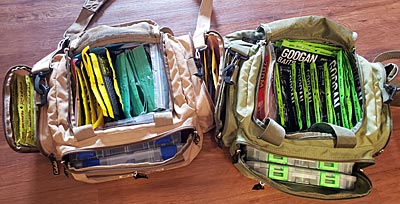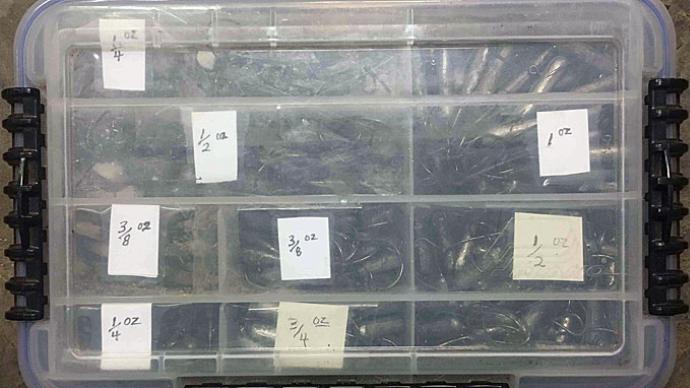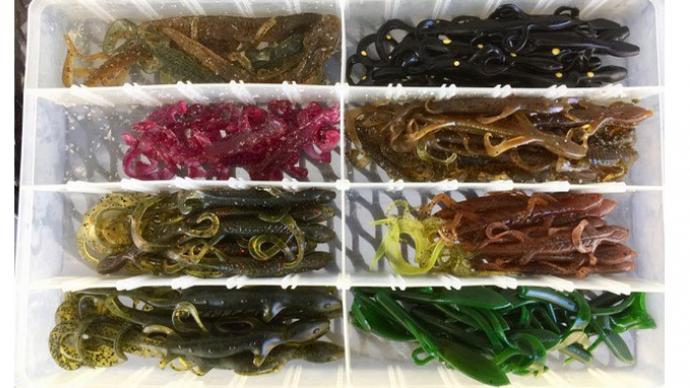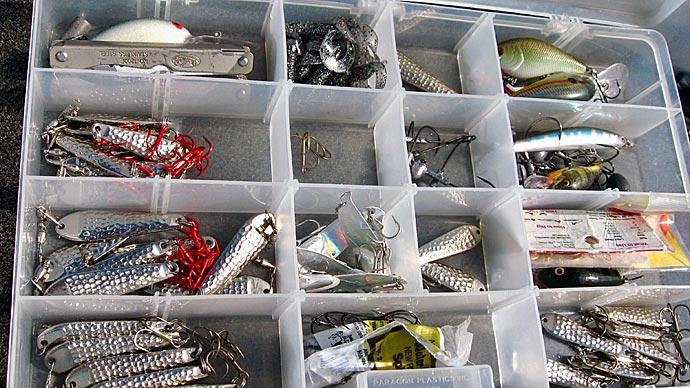
After a few years of fishing, it’ll seem like you have accumulated thousands of lures and pounds of gear in your boat or storage closet. Just the thought of digging through it to wet a line can turn you off fishing and have you hoping that the magical fishing fairy maids will sort through it. I’ve been there. Chances are you’ve been there. And any serious angler has, without a doubt, been there, too. But it doesn’t have to be the hurdle that it seems. Here are the steps to streamlining your tackle system and organizing it economically and sustainably. It can be a fun project.
Spread Out Everything
While this step may be embarrassing, I tend to chalk it up to the school of hard knocks. Once all your mess is in front of you, you’ll re-absorb a lesson most of us have long forgotten — discipline. Yes, you probably will be uncomfortable looking face to face at a mess you made, admitting in the process that you allowed it to happen. But it will help you move forward because you won’t let it get that bad again. I promise.
The benefit of laying everything out — use your whole garage or driveway if you have to — is that you can quickly assess what you need in the following steps while identifying needs and wants for future tackle and equipment upgrades. It’s difficult to remember what you need when everything is out of sight and thus out of mind, but it’s hard to ignore when it’s all in front of you.
Begin To Associate
If you have an anchor and rope, you probably don’t stow it with your crankbaits, no matter how often they snag each other when in use. But if your anchor and rope are separated, find them and put them together.
Follow this method for every item you store in your boat or bring on each fishing trip. Set these items in a group away from the others you have spread out. Once all essential items are removed, move on to the next category.
Repeat this process for all your gear, from lures to fire extinguishers. You’ll find that it’s a quick process. Remember, this isn’t detailed cleaning and organization. The goal is to separate your gear into categories. The details will be addressed later.
Clean And Prepare
Now that everything is categorized, clean what you have, including your boat or storage closet. It’ll never be more accessible than when they are empty. This will help lengthen the life span of your investment. After all, fishing isn’t cheap.
This is a simple task. It doesn’t take much effort, only some good cleaning products, and elbow grease. Be sure all your gear is dry before moving to the next step. While it dries, sit down and enjoy some coffee and a sandwich. The following steps will take more focus.
Organize And Restock
The moment of truth has arrived. It’s time to organize your fishing gear in an orderly fashion that will maximize storage and improve access.
Start with the large items: life jackets, oars, fire extinguishers, medical kits, and anchors. That will address the largest gear, allowing you to focus on smaller items. Note the ones that are missing, so you can acquire them later. If your anchor rope is in poor condition or missing, add it to your shopping list under “Boat Needs.” If you have 200 lures and one tackle box, add a couple under “Tackle Needs.” And if you have one lure in 23 colors but another in only six, list more of the latter under “Tackle Wants.” You don’t need every lure in every available color. Keep it simple. I’m married to that principle in lure selection and boat organization.

Organizing a large amount of tackle can be tricky for first-timers. Here’s how I do it: You can apply what you feel will work for you and your tackle. First, I put all my lures into one of three categories: soft, jig, or hard. That will keep you out of the weeds, helping you quickly locate lures in the future.
If it’s a soft-plastic lure, it comes in a bag, so I store it in a bag. I use two Cabela's catch-all mini duffle bags. In them, I carry about 15 pounds of soft-plastic lures. They are organized by type, and in my case, by brand. That makes it easy to remember where your Senkos and soft-bodied swimmers are stowed.
The bags also have about 5 pounds of terminal tackle organized in small tackle boxes and an O-ring set for wacky rigging. I keep everything associated with soft plastics in the bags. So, when I need a soft plastic, I can rip out a bag, tie one on and toss the bag. I’m not searching through compartments, trying to find everything I need, for example, to build a Carolina rig.
If you don’t fish jigs often, you may only have a few. But if you’re like me, you swing a jig at every opportunity. And that means real estate in your boat’s storage compartment quickly becomes a hot commodity because you haven’t added any hard baits yet.
I store my jigs without trailers to put more in less space. I usually carry several of the same size and style jig in three or four colors. That’s a lot of jigs — almost 40 pounds — when you consider I have bladed, football, finesse, micro, ball-head, swimming, casting, and punching ones. I put all the same style, weight, and color jigs in the same tackle-box slot. That way, it doesn’t matter which jig I grab from one. It’s the one that I want.
Next comes hard baits. Topwaters, swimbaits, buzzbaits, square bills, lipless cranks, medium-diving crankbaits, deep-divers, and jerkbaits each get their own box. So do my frogs. I also fill a medium-sized tackle box with split rings and treble hooks. That selection of extras allows me to doctor or repair my plugs while on the water.
All my tackle fits into 17 large tackle boxes and six small ones. So, I need a storage solution to handle all my needs and protect my investment. I use Lure Lock boxes. These boxes are rigid. They don’t break, even those left on the deck that I accidentally step on while netting a bass. Their snap-apart dividers always fit flush the first time. That will speed up your tackle overhaul process.
Now that your tackle is squared away turn your attention to your rods and reels. Maintaining them is pretty straightforward. But before you toss them in your boat, ensure your reels have fresh line, and each rod is placed in a sleeve. Even the best riding and designed boats can’t protect your outfits from each other in a compartment. While the sleeves won’t save them from impacts, they will minimize tangles between line and guides. They also let you quickly remove a rod. That adds speed and efficiency to your fishing game.
As you place your gear, piece by piece, in your boat, take inventory of what you have and don’t have. That way, your next tackle-shopping spree will be targeted and productive.
Ready To Hit The Water
Once your tackle, rods and reels, and general boating gear are squared away and easily accessible, you’ll begin enjoying and reaping the rewards. After all, the more time you spend dangling your lure in the water than looking for it, the more productive you’ll be on the water.

Patrick Garrett is a professional angler from Easley, South Carolina. He fishes full time in the MLF Tour and is a Pro Staff Angler, dad, husband, dog lover, and instructor of advanced fishing techniques.




